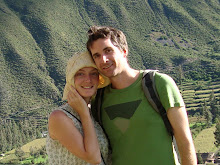 A large, Victorian-style wooden house in Bluefields. A lot were destroyed by hurricanes in the 1990s. So now, the pretty houses are out-numbered by uglier concrete structures.
A large, Victorian-style wooden house in Bluefields. A lot were destroyed by hurricanes in the 1990s. So now, the pretty houses are out-numbered by uglier concrete structures. Near to the port in Bluefields. Lots of wooden buildings. Large boats come and go as well as locally-crafted dug-out canoes for fishing
Near to the port in Bluefields. Lots of wooden buildings. Large boats come and go as well as locally-crafted dug-out canoes for fishing  These old containers were being used as offices and shops in Bluefields.
These old containers were being used as offices and shops in Bluefields.Moving on to the small, sleepy town of Laguna de Perla, the Spanish community reduced, and Misquito people lived alongside Creole. Menus were dominated by prawns and fish stewed in coconut milk and there were large shrimping boats in the dock. Although the roads were sandy, there were a few vehicles around, as the road to Rama and the rest of the country has recently been improved.
A couple of kilometres walk from Pearl Lagoon town, along a raised track through a swamp, led us to the Misquito settlement of Awas. The Misquito people are indigenous to Central America, and the largest population lives in Honduras. The people we visited in Awas through a community tourism venture, still live a simple life growing their own food, mainly yucca, and making a little bit of money from fishing and community tourism. We were made very welcome in the house of Orlando (centre in the photo) and his family. 

The Garifuna people are descended from people who escaped from British slave ships in the 17th century, found refuge on the Caribbean island of San Vicente, and later migrated to a number of islands and communities around the Central American Caribbean coast. Orinoco, a further hour's bumpy boat trip across Pearl Lagoon are one such community. There were no cars in this village, the only form of transport was boat, as it is hemmed in on all sides by jungle. It was a nice community with lots of children playing around the houses and in a large, community grassy square. There is a tradition of African drum music, and we enjoyed listening to some local lads gathered in the street for an impromptu drum session.  Orinoco
Orinoco One of the main streets in Orinoco.
One of the main streets in Orinoco.
 The village drumming workshop where drums are made.
The village drumming workshop where drums are made.
The small town of Pueblo Nuevo didn't have any road transport either. It was all horseback or boats. But it did have a very different feel to anywhere else we had visited. The vast majority of people were Spanish-speaking Nicaraguans. They made their way from further west, clearing forest land for cattle grazing as they went. It was highly politicised when we passed through as candidates for local elections were on the campaign trail, albeit by boat.

The Sandinista FSLN flags were out in force as were those of several opposition parties, including the right-wing PLC. The variety of life we encountered made the trip worth the effort for us.
The variety of life we encountered made the trip worth the effort for us.
 Orinoco
Orinoco One of the main streets in Orinoco.
One of the main streets in Orinoco.  The village drumming workshop where drums are made.
The village drumming workshop where drums are made.The small town of Pueblo Nuevo didn't have any road transport either. It was all horseback or boats. But it did have a very different feel to anywhere else we had visited. The vast majority of people were Spanish-speaking Nicaraguans. They made their way from further west, clearing forest land for cattle grazing as they went. It was highly politicised when we passed through as candidates for local elections were on the campaign trail, albeit by boat.

The Sandinista FSLN flags were out in force as were those of several opposition parties, including the right-wing PLC.
 The variety of life we encountered made the trip worth the effort for us.
The variety of life we encountered made the trip worth the effort for us.


No comments:
Post a Comment